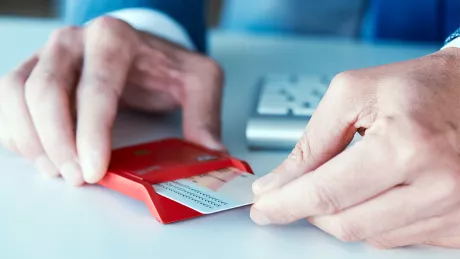
How to replace your handwritten signature in just four steps
published on 01.05.2018
Find out how to use the binding electronic signature as remote signature in your company in a convenient manner and without any change in media.
The remote electronic signature
In the age of digitisation, paper-based procedures are often outdated, time-consuming and costly. Many of these procedures can now be digitised while remaining secure and fast. Lutz Graf from Bundesdruckerei GmbH explains how, in just four steps, you can use the binding electronic signature as a remote signature at your company in a convenient manner and without any change in media. Get fit for Europe and use sign-me to implement the new Council Regulation on 'electronic identification and trust services for electronic transactions in the internal market' (eIDAS) which came into effect on 1 July 2016 in all EU Member States. eIDAS enables trusted electronic interaction between public authorities, businesses and consumers.
Step 1: Implementing the eIDAS Regulation and overcoming paper-based processes
Fifty percent of IT users around the world consider the handwritten signature to be the greatest hurdle on the route to 'paperless' processes. At the same time, 50 percent of people under the age of 30 already use their smart phone for banking and fully exploit the technical possibilities offered. This shows that the readiness to use online-based applications is great.
As of summer 2016, the eIDAS Regulation will create the legal basis for remote, online electronic signatures without a card reader. No signature cards or signature software are needed for the remote signature with sign-me. Signatures can be initialised simply via a tablet, PC or smart phone.
Step 2: Save money and resources with sign-me
sign-me is Bundesdruckerei's solution for the binding online signature. It can be easily and conveniently integrated into your Internet portal. Today, you have to offer specific opening hours and plan the time needed for sending and returning documents. sign-me, however, can be conveniently integrated into existing infrastructures and workflows and hence enables automated processes. sign-me provides you with an easy, yet very user-friendly procedure that complies with all eIDAS requirements. And you can work entirely without paper. Since the Internet application can be used at any location, sign-me offers a 24/7 service and you can immediately process documents that were signed online.
One example:
A customer decides to enter into a mobile phone contract. In the past, the customer had to print the document at least twice, sent it by post and undergo an identification procedure at the post office or an appointment had to be made. If the customer had not changed his mind by then and returned the contract, you now had to digitise this again in a time-consuming process.
Thanks to the completely paperless workflow, sign-me not only saves you costs and archiving of the printed documents, it will also save both the customer and you a lot of time. With sign-me, your company will improve its efficiency and provide greater convenience for your customer. Waiting times and postage now become a thing of the past.
Step 3: sign-me in practical use
In the following, we will show you some examples of how sign-me could work.
1: Initiating the signature process
To use sign-me, your customer needs neither a signature card nor signature software. The sign-me signature service will be integrated into the existing ordering process used by the mobile phone provider. The customer is automatically directed from the ordering process to the sign-me interface which appears as a pop-up or overlay on the mobile phone provider's website.
2: Free Registration
Customers who have not yet registered with sign-me go through a registration process and are then identified (see step 3).
If the customer is already registered with sign-me and has been verified, all he has to do is click 'Online signing with sign-me' on the mobile phone contract document that is open on the screen. The user then logs in with sign-me by entering his username and transaction number and step 2 and 3 can be omitted. The customer can now directly proceed to step 4.
3: Personal verification
In order to warrant the binding nature of the online signature, the user must first perform once-off identity verification.
4: Signing the document digitally in a binding manner
Following successful verification, the remote signature is now possible. The customer receives a personal code on his smart phone which he has to enter online. Then, he has to confirm this by clicking 'Signing online'. The document is now signed online.
Via the sign-me portal, an optical feature now appears on the digitally signed document.
The customer has now successfully signed the contract in a legally binding manner. The document can be processed immediately by the company and the customer can send it to his e-mail address.
Step 4: Who can work with sign-me?
Where can sign-me be used? sign-me can be used everywhere where the classical handwritten signature is required today, for instance, at banks and insurance companies, at public authorities and in the health sector.
The enormous advantage of sign-me is that the customer can perform the online signature procedure no matter where and when. Instead of card readers or special software, all the user now needs is a tablet or PC and a smart phone to perform all procedures that require a signature.
Advantages at a glance
- Completely paperless
- Concluding contracts without changing media
- Quicker than with the handwritten signature
- No additional costs for the end customer
- eIDAS-compliant
- Convenient integration of sign-me into existing infrastructures and workflows
- Easy, very user-friendly procedure






